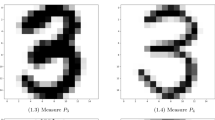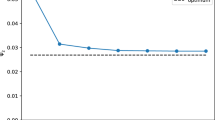Abstract
The discrete Wasserstein barycenter problem is a minimum-cost mass transport problem for a set of probability measures with finite support. In this paper, we show that finding a barycenter of sparse support is hard, even in dimension 2 and for only 3 measures. We prove this claim by showing that a special case of an intimately related decision problem SCMP—does there exist a measure with a non-mass-splitting transport cost and support size below prescribed bounds? Is NP-hard for all rational data. Our proof is based on a reduction from planar 3-dimensional matching and follows a strategy laid out by Spieksma and Woeginger (Eur J Oper Res 91:611–618, 1996) for a reduction to planar, minimum circumference 3-dimensional matching. While we closely mirror the actual steps of their proof, the arguments themselves differ fundamentally due to the complex nature of the discrete barycenter problem. Containment of SCMP in NP will remain open. We prove that, for a given measure, sparsity and cost of an optimal transport to a set of measures can be verified in polynomial time in the size of a bit encoding of the measure. However, the encoding size of a barycenter may be exponential in the encoding size of the underlying measures.







Similar content being viewed by others
References
Anderes E, Borgwardt S, Miller J (2016) Discrete Wasserstein barycenters: optimal transport for discrete data. Math Methods Oper Res 84(2):389–409
Benamou J-D, Carlier G, Cuturi M, Nenna L, Peyré G (2015) Iterative Bregman projections for regularized transportation problems. SIAM J Sci Comput 37(2):A1111–A1138
Borgwardt S (2020) An LP-based, strongly polynomial 2-approximation algorithm for sparse Wasserstein barycenters. Oper Res 2020:1–41
Borgwardt S, Patterson S (2020) Improved linear programs for discrete barycenters. INFORMS J Optim 2:14–33
Carlier G, Duval V, Peyré G, Schmitzer B (2017) Convergence of entropic schemes for optimal transport and gradient flows. SIAM J Math Anal 49(2):1385–1418
Cuturi M, Doucet A (2014) Fast computation of wasserstein barycenters. In: Proceedings of the 31st international conference on machine learning (ICML-14). JMLR Workshop and Conference Proceedings, pp 685–693
Dyer ME, Frieze AM (1986) Planar 3DM is NP-complete. J Algorithms 7:174–184
Karp RM (1972) Reducibility among combinatorial problems. In: Miller RE, Thatcher JW, Bohlinger JD (eds) Complexity of computer computations. The IBM research symposia series. Springer, Boston, MA. https://doi.org/10.1007/978-1-4684-2001-2_9
Luise G, Rudi A, Pontil M, Ciliberto C (2018) Differential properties of Sinkhorn approximation for learning with Wasserstein distance. Adv Neural Inf Process Syst (NIPS) 31:5859–5870
Miller J (2016) Transportation networks and matroids: algorithms through circuits and polyhedrality. PhD thesis, University of California Davis
Panaretos V, Zemel Y (2019) Statistical aspects of Wasserstein distances. Ann Rev Stat Appl 6(1):405–431
Pferschy U, Rudolf R, Woeginger G (1994) Some geometric clustering problems. Nordic J Comput 1:246–263
Rabin J, Peyre G, Delon J, Bernot M (2012) Wasserstein barycenter and its application to texture mixing. Scale space and Variational methods in computer vision. Lect Notes Comput Sci 6667:435–446
Spieksma F, Woeginger G (1996) Geometric three-dimensional assignment problems. Eur J Oper Res 91:611–618
Tardos E (1986) A strongly polynomial algorithm to solve combinatorial linear programs. Oper Res 34(2):250–256
Tenetov E, Wolansky G, Kimmel R (2018) Fast entropic regularized optimal transport using semidiscrete cost approximation. SIAM J Sci Comput 40(5):3400–3422
Villani C (2009) Optimal transport: old and new, vol 338. Springer, Berlin
Yang L, Li J, Sun D, Toh K-C (2020) A Fast globally linearly convergent algorithm for the computation of Wasserstein barycenters. e-print arXiv:1809.04249
Acknowledgements
This work was supported in part by the Simons Foundation [grant number 524210]. S. Borgwardt gratefully acknowledges support through the Collaboration Grant for Mathematicians Polyhedral Theory in Data Analytics (grant number 524210) of the Simons Foundation.
Author information
Authors and Affiliations
Corresponding author
Additional information
Publisher's Note
Springer Nature remains neutral with regard to jurisdictional claims in published maps and institutional affiliations.
Rights and permissions
About this article
Cite this article
Borgwardt, S., Patterson, S. On the computational complexity of finding a sparse Wasserstein barycenter. J Comb Optim 41, 736–761 (2021). https://doi.org/10.1007/s10878-021-00713-5
Accepted:
Published:
Issue Date:
DOI: https://doi.org/10.1007/s10878-021-00713-5




